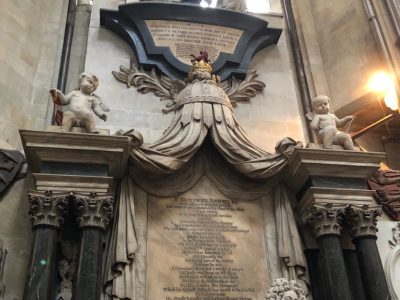
4 minute mile man in Westminster Abbey
This memorial to Roger Banister (1929-2018) was unveiled in 2021 in Westminster Abbey. He is best known as the first person to run a mile in less than 4 minutes on 6 May 1954 at Oxford’s Iffley Road track.

One of his pacemakers was Christopher Chataway who became a broadcaster then an MP. The other was Chris Brasher, co-founder with John Disley in 1981 of the London Marathon.
Banister studied medicine at Oxford and was a working as a junior doctor at St Marys, Paddington when he achieved this feat.
He became a neurologist. His speciality was the study and treatment of the automatic nervous system controlling functions such as heartbeat and blood pressure.
He said he was more proud of his medical career than his athletics.
The Abbey is a great place to visit because there are so many memorials and every time I go I see something new.
We are now allowed to take photos in the Abbey as long as there is no service going on. Here are some of my snaps shots.
It is impossible to talk about all of them on a guided tour so this blog is my chance to talk about few that don’t get usually a mention in my live tours.
St Paul’s Chapel

The Abbey has several chapels that once had altars dedicated to different saints.
Probably the most colourful tomb if the whole building is in St Pauls chapel. It belongs to Sir Lewis Robessart (c1390-1430).
The paint is relatively fresh because it had been whitewashed during C19th. It was repainted to its original colours in 1968 during restoration work.
Sir Lewis Robessart was from Hainaut in Belgium. His family had a long history of fighting for English kings since Edward III married Philippa of Hainaut.
Robessart had been squire to Henry V before he came to the throne and had fought with him at Agincourt. In 1520 he became standard bearer to the king.
He died in battle near Amiens in Flanders. His wife, Elizabeth Bourchier commissioned the elaborate tomb. She died 3 years later and was buried with her husband.
The tomb decoration features the Order of the Garter, Sir Lewis was made a member In 1421. In the middle is a head of a man with long, plaited hair, described as a Saracen. On top of the head is a wheel, the symbol of St Catherine. This is possibly a reference to Baldwin IV of Jerusalem defeating Saladin against expectations at the Battle of Montsigard in 1177 on the feast day of St Catherine.
Baldwin built a monastery dedicated to her in thanks. Baldwin’s family were originally from Flanders.
At one end is a silver falcon and the other a golden lion (a Robessart symbol). Dotted all over are black water bougets (these are yokes from which hang two leather water containers and part of the Bourchier family arms).
In C19th the tomb lid was damaged when a huge statue to James Watt was brought into this side chapel. Watt’s statue was removed in 1968 because it looked out of place in this chapel.
A slab was put on the floor to commemorate James Watt instead of the statue. In 2014 the slab to Watt’s partner, Matthew Boulton was added.
Mathew Boulton’s family made small metal objects such as buckles in Birmingham.
He used new technologies to create larger objects such as silver-plated tableware and decorative vases. To do this economically he needed to have an assay office near the factory and campaigned successfully for one to be created in Birmingham.
His factory used water-power but Scottish engineer James Watt had been developing steam engines to power machinery. Boulton realized that not only would steam engines help his production, he could install steam engines to pump water out of coal mines for a fee. This led to Boulton and Watt becoming business partners in 1775.
For a private guided tour of Westminster Abbey Contactez-moi








